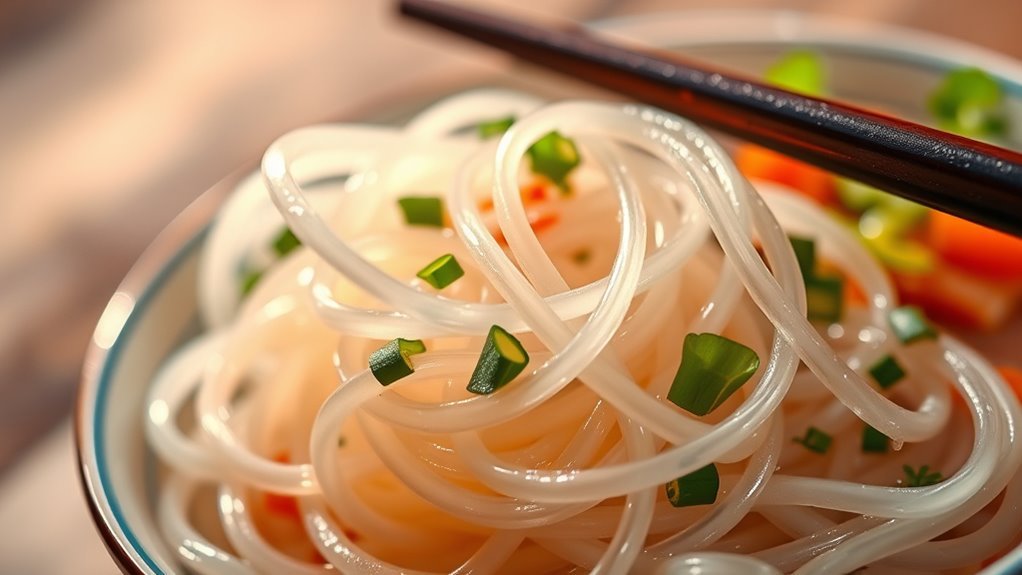Glass noodles aren’t keto-friendly due to their high carbohydrate content. With around 35 grams of carbs per 100 grams, they can spike your blood sugar and disrupt ketosis. If you’re sticking to a strict keto diet, you’ll want to watch your intake. However, there are great alternatives like zucchini noodles and shirataki noodles that fit better within your carb limits. Keep exploring to find ways to stay on track with your keto lifestyle.
Understanding Glass Noodles

Glass noodles, often found in Asian cuisine, are a unique type of noodle made primarily from starches such as mung bean, sweet potato, or tapioca. Their origin can be traced back to China, where they were first used in traditional dishes. You’ll find that glass noodles are versatile and can be prepared through various cooking methods, including boiling, stir-frying, or soaking in hot water. Once cooked, they become translucent and have a chewy texture, making them a popular choice in soups and salads. These noodles absorb flavors well, allowing you to experiment with different sauces and ingredients. Whether you’re enjoying a spicy stir-fry or a light salad, glass noodles can offer a delightful addition to your culinary adventures.
Nutritional Profile of Glass Noodles

When examining the nutritional profile of glass noodles, it’s vital to take into account their composition and how they fit into various dietary plans. These noodles, made primarily from mung bean starch or sweet potato starch, offer a unique nutritional value:
- Low in calories: A typical serving has around 60 calories.
- Gluten-free: They’re a great option for those with gluten sensitivities.
- Rich in carbohydrates: Providing quick energy, but not ideal for strict keto diets.
While glass noodles can be a delicious addition to meals, their nutritional value may not align with all dietary choices, especially if you’re monitoring carbs. Understanding these aspects helps you make informed decisions about incorporating them into your meals.
Carb Content Comparison

Understanding the carb content of glass noodles is important for anyone considering their dietary options, particularly those on low-carb or keto diets. Typically made from mung bean starch, glass noodles contain around 35 grams of carbs per 100 grams. In contrast, traditional pasta has a higher carb count, often exceeding 70 grams. If you’re seeking keto substitutes, consider alternatives like zucchini noodles or shirataki noodles, which are considerably lower in carbs. While glass noodles can serve as a carb source in moderation, their high carb content may not align with strict keto guidelines. Always weigh your options, focusing on lower-carb alternatives that better suit your dietary needs, allowing you to enjoy meals without compromising your goals.
Impact on Ketosis
Although glass noodles can be a tempting option for various dishes, their high carb content can considerably impact your ability to maintain ketosis. If you’re serious about your carb restrictions, you’ll want to be cautious. Here are some ketosis effects to reflect upon:
- Increased Blood Sugar Levels: The carbs in glass noodles can spike your blood sugar, disrupting ketosis.
- Reduced Fat Burning: Consuming high-carb foods can hinder your body’s ability to burn fat for fuel, essential for staying in ketosis.
- Keto Flu Symptoms: If you consume too many carbs, you might experience symptoms like fatigue and irritability as your body struggles to readjust.
Staying mindful of these factors can help you make better choices that support your keto lifestyle.
Alternatives to Glass Noodles
If you’re looking for alternatives to glass noodles, zucchini noodles and shirataki noodles are popular options. Zucchini noodles, or “zoodles,” are low in calories and carbs while providing fiber and nutrients. On the other hand, shirataki noodles are made from konjac yam, offering a virtually calorie-free choice that’s high in glucomannan fiber, making them a great fit for a keto diet.
Zucchini Noodles Benefits
While glass noodles offer a unique texture, zucchini noodles present an appealing alternative, especially for those following a keto diet. These low-carb noodles come with several health benefits that can enhance your meals without compromising your dietary goals. Here are a few reasons to take into account zucchini noodles:
- Low in Calories: Zucchini noodles are considerably lower in calories than traditional pasta, making them an excellent choice for weight management.
- Rich in Nutrients: They provide essential vitamins and minerals, including vitamin C and potassium, which support overall health.
- High in Fiber: Zucchini noodles help keep your digestive system healthy and can aid in maintaining a feeling of fullness.
Incorporating zucchini noodles into your diet not only satisfies your cravings but also boosts your nutrition effortlessly.
Shirataki Noodles Overview
Shirataki noodles, often hailed as a low-carb alternative to traditional pasta, are made from the konjac plant’s root. They’re virtually calorie-free and packed with glucomannan, a soluble fiber that may aid digestion and promote a feeling of fullness. The shirataki noodles benefits extend to those following a keto regimen, as they help keep your carb count low while allowing you to enjoy a pasta-like meal.
For shirataki noodles preparation, simply rinse them under cold water and heat them in a pan for a few minutes. You can pair them with your favorite sauces, vegetables, or proteins, making them a versatile option. Their unique texture can be an interesting addition to various dishes, giving you freedom in your culinary choices.
Incorporating Low-Carb Options
When you’re exploring low-carb options for your meals, glass noodles can be a tempting choice, but they may not fit neatly into a keto diet. Instead, consider incorporating other low-carb alternatives into your meal prep to stay on track. Here are some suggestions for low-carb recipes:
- Zucchini Noodles: Spiralized zucchini makes a great pasta substitute and is low in carbs.
- Shirataki Noodles: These are made from konjac yam and contain almost no calories or carbs.
- Cauliflower Rice: A versatile base for stir-fries or grain bowls, it’s low in carbs and high in fiber.
Tips for a Successful Keto Diet
Sticking to a keto diet can be challenging, especially when managing food choices that might seem low in carbs but can derail your progress. To succeed, start with meal planning. This helps you stay organized and guarantees you stick to your carb limits. Focus on whole, unprocessed foods to maximize nutrients while minimizing carbs.
Don’t overlook portion control; even keto-friendly foods can contribute to weight gain if eaten in excess. Use measuring tools or keep a food diary to track your intake.
Lastly, be flexible. If a meal doesn’t go as planned, don’t stress. Adapt and learn from it. Remember, the goal is sustainable changes that fit your lifestyle, giving you the freedom to enjoy your food choices.
Frequently Asked Questions
Are Glass Noodles Gluten-Free?
You might think glass noodles are made of glass, but they’re actually crafted from mung bean starch, making them gluten-free. Their ingredients provide a low-calorie option, which can be a nutritional benefit for many. However, while they lack gluten, they’re still high in carbohydrates, so moderation is key. If you’re looking for a versatile ingredient that fits your dietary needs, glass noodles might just offer the freedom you seek in your meals.
How Are Glass Noodles Made?
Glass noodles are made from starch, typically mung bean or sweet potato, which gives them their translucent appearance. The process involves soaking the starch, mixing it with water, and then steaming it to create thin sheets. These sheets are cooled and cut into noodles. Historically, glass noodles have roots in Asian cuisine, dating back centuries. Their unique texture and ability to absorb flavors make them popular in various dishes across cultures.
Can I Find Glass Noodles in Supermarkets?
Yes, you can find glass noodles in most supermarkets, often in the Asian foods aisle. They come in various varieties, like mung bean and sweet potato, catering to different tastes. If you’re looking for noodle substitutes, glass noodles are a popular choice due to their unique texture and ability to absorb flavors. Just check the packaging for specific ingredients if you have dietary restrictions, as some varieties may differ in composition.
What Dishes Commonly Use Glass Noodles?
Glass noodles are versatile and can be found in various dishes. You’ll often see them in stir fry recipes, where they soak up flavors beautifully. They’re also popular in soup options, adding a delightful texture to broths. Dishes like Korean Japchae or Thai Pad Woon Sen showcase their adaptability, making them a staple in many Asian cuisines. So, when you’re looking for something unique, glass noodles are a great choice!
How Long Do Cooked Glass Noodles Last?
Cooked glass noodles can last about 3 to 5 days in the refrigerator. To maximize freshness, store ’em in airtight storage containers, ensuring they’re completely cooled before sealing. This prevents moisture buildup, which can lead to spoilage. If you’re not planning to eat them soon, consider freezing for longer storage. Just remember to reheat thoroughly when you’re ready to enjoy! Following these refrigeration tips keeps your meals delicious and safe.


